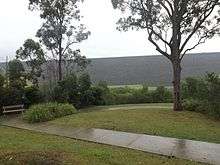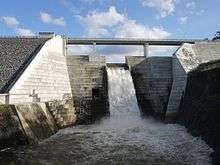Hinze Dam
The Hinze Dam is a rock and earth-fill embankment dam with an un-gated spillway across the Nerang River in the Gold Coast hinterland of South East, Queensland, Australia. The main purpose of the dam is for potable water supply of the Gold Coast region.[1][5] The impounded reservoir is called Advancetown Lake.
| Hinze Dam | |
|---|---|
.png) Spillway tower of Hinze Dam following Stage 3 upgrade, 2011 | |
 Location of the Hinze Dam in Queensland | |
| Country | Australia |
| Location | South East Queensland |
| Coordinates | 28°3′2″S 153°17′2″E |
| Purpose |
|
| Status | Operational |
| Opening date |
|
| Operator(s) | SEQ Water |
| Dam and spillways | |
| Type of dam | Embankment dam |
| Impounds | Nerang River |
| Height | 108 m (354 ft)[1] |
| Length | 1,850 m (6,070 ft)[2] |
| Dam volume | 4,261×103 m3 (150.5×106 cu ft)[1][3] |
| Spillway type | Uncontrolled |
| Spillway capacity | 550 m3/s (19,000 cu ft/s)[3] |
| Reservoir | |
| Creates | Advancetown Lake |
| Total capacity | 310,730 ML (6.835×1010 imp gal; 8.209×1010 US gal)[2][4] |
| Catchment area | 207 km2 (80 sq mi)[2] |
| Surface area | 1,500 ha (3,700 acres)[2] |
| Normal elevation | 82 metres (269 ft) AHD |
| Website www.seqwater.com.au | |
Hinze Dam was named in honour of local pioneers Carl and Johanna Hinze (grandparents of Queensland politician Russ Hinze) who lived in the valley that was flooded by the dam.[6][7]
Location and features

The dam is located in Advancetown, 15 kilometres (9.3 mi) south-west of Nerang immediately downstream of the confluence of the Nerang River and Little Nerang Creek.[5]
.png)
The earthfill dam structure is 108 metres (354 ft) high and 1,850 metres (6,070 ft) long. The 4,261-thousand-cubic-metre (150.5×106 cu ft) dam wall holds back the 310,730-megalitre (6.835×1010 imp gal; 8.209×1010 US gal) reservoir when at full capacity. From a catchment area of 207 square kilometres (80 sq mi) that includes the Numinbah Valley and Springbrook Plateau, with most being contained within state forests and national parks, the dam creates Advancetown Lake, with a surface area of 1,500 hectares (3,700 acres). The uncontrolled un-gated spillway, located at 82 metres (269 ft) above sea level, has a discharge capacity of 550 cubic metres per second (19,000 cu ft/s).[1][2][3] Initially managed by the Gold Coast City Council up until 2008, the dam is now managed by Seqwater.[4]
The dam also provides the benefit of flood mitigation to populated areas along the Nerang River downstream of the dam.[3]
Construction
_-_Spillway.png)
The Southport Town Council planned the dam in 1947.[8] It was completed in 1976 and expanded in 1989 and 2011.
Stage One was completed in 1976, and provided 42,400 megalitres (9.3×109 imp gal; 1.12×1010 US gal) of potable water storage and supply.
Stage Two was completed in 1989, when storage of potable water was increased to 161,070 megalitres (3.543×1010 imp gal; 4.255×1010 US gal). This stage was completed at a cost of A$42 million and involved raising the main embankment, spillway and intake towers by approximately 18 metres (59 ft) to create a surface area of 9.72 square kilometres (3.75 sq mi).[1]
In 2004 the Gold Coast City Council resolved to construct Stage 3 of the dam. When the dam reached full capacity, on 7 January 2008 work began on Stage 3[9] and was completed on 19 December 2011. After nearly four years of construction the construction cost was A$395 million.[3][4] The Stage 3 works increased the height of the dam wall from 93.5 metres (307 ft) to 108 metres (354 ft), and increased the reservoir capacity from 161,070 megalitres (3.543×1010 imp gal; 4.255×1010 US gal) to 310,730 megalitres (6.835×1010 imp gal; 8.209×1010 US gal), with the added purpose of flood mitigation, beyond water supply.[3][4][10] Stage 3 construction was completed by the Hinze Dam Alliance, a joint venture between Seqwater, with private sector partners URS Corporation, Sinclair Knight Merz and Thiess. The additional works with a higher dam wall provided 4,500 homes below the dam wall with flood protection from a 1974 Brisbane–style flood event.[10]
The eastern boat ramp is located in Mudgeeraba and features a craft and paddle launching platform as well as toilets and bin facilities. The western boat ramp, located in Springbrook, contains the same amenities with a smaller car park. In 2012 a body was discovered by fishermen.[11]
Recreation
Advancetown Lake is a popular recreational facility for Gold Coast residents. Since the Stage 3 upgrade, recreational activities allowed include walking, electric or manual-powered boating, fishing, biking and horse riding. The facilities are open from 6 am to 6 pm daily.[4] No camping is permitted around the lake.[5] Dogs are also not permitted, while swimming has been strongly discouraged.[12] An interpretive centre was opened on 19 December 2011, along with new parking, walking trails, toilet facilities and barbecue areas.[4]

The final design of the dam was criticised in the media and by residents and politicians, some describing it as a "concrete bunker". The criticism arose because of a reduction in playground, boating and barbecue facilities; the banning of dogs; the extensive use of concrete; and because many of the facilities are either far from the water's edge or below the dam wall with no water views.[12]
Advancetown Lake has two boat ramps, one on the western and another on the eastern side.
Fishing
The dam is stocked with Mary River cod, silver perch, golden perch, southern saratoga and bass, while spangled perch are also present naturally.[5] Banded grunter have been found in the lake and being illegally introduced, it is recommended that, if caught, they should be destroyed.[5] A Gold Coast City Council permit is required to fish in the dam.[13] A Queensland State Government Stocked Impoundment Permit is not required.[14]
From December 2018, Queensland Health advise not to consume fish from Hinze Dam due to elevated levels of mercury in recent fish samples.[15]
2018 Commonwealth Games
The Gold Coast hosted the 2018 Commonwealth Games. The area surrounding the Hinze Dam was originally proposed as the location for the mountain bike competition. A new course was constructed to meet international competition requirements. Some government representatives as well as some mountain bikers have sought to have the competition moved away to the unsecured trails at Nerang State Forest. The Gold Coast Mountain Bike Club maintain the course and sometimes host a race on the circuit the first Sunday of each month.[16]
References
- "Register of Large Dams in Australia" (Excel (requires download)). Dams information. Australian National Committee on Large Dams. 2010. Archived from the original on 12 December 2013. Retrieved 23 June 2014.
- "Hinze Dam". Water supply: Dams and weirs. Seqwater. 2014. Archived from the original on 14 April 2014. Retrieved 1 July 2014.
- "Hinze Dam Stage 3 Information" (PDF). Fact sheet (PDF). SEQ Water. 2011. Archived from the original (PDF) on 2 April 2015. Retrieved 3 July 2014.
- "Hinze Dam reopens to the public". Hinze Dam / Advancetown Lake. SEQ Water. 19 December 2011. Archived from the original on 7 January 2012. Retrieved 25 December 2011.
- Harrison, Rod; James, Ernie; Sully, Chris; Classon, Bill; Eckermann, Joy (2008). Queensland Dams. Bayswater, Victoria: Australian Fishing Network. pp. 58–59. ISBN 978-1-86513-134-4.
- What's in a Name: Hinze Dam. Brisbane, Queensland: ABC Radio. 5 June 2012. Archived from the original (streaming audio) on 14 July 2014. Retrieved 2 July 2014.
- Thomson, Alister (25 July 2016). "Hinze dam at Advancetown reaches middle age". Gold Coast Bulletin. Retrieved 1 June 2019.
- "SOUTHPORT'S BIG WATER SCHEME". The Courier-Mail. Brisbane: National Library of Australia. 28 January 1947. p. 3. Retrieved 19 April 2014.
- "Heavy Gold Coast rains fill Hinze Dam". ABC News. Australian Broadcasting Corporation. 7 January 2008. Archived from the original on 9 February 2008. Retrieved 11 July 2011.
- Lappeman, Suzanne (11 March 2011). "Upgrade of Hinze Dam wall finished". Gold Coast Bulletin. Archived from the original on 16 April 2011. Retrieved 11 July 2011.
- "Archived copy". Archived from the original on 27 March 2017. Retrieved 26 March 2017.CS1 maint: archived copy as title (link)
- Tuttiett, Henry (19 December 2011). "Hinze Dam re-opens after $395m facelift". Gold Coast Bulletin. Archived from the original on 10 January 2012. Retrieved 25 December 2011.
- "Gold Coast City Council - Fishing". 23 November 2010. Archived from the original on 7 August 2011. Retrieved 12 August 2011.
- "Queensland Government Primary Industries and Fisheries - Do I need a permit to go fishing in a dam?". 1 July 2011. Archived from the original on 12 September 2011. Retrieved 12 August 2011.
- "Hinze Dam". Fish Stocked Dams and Weirs. Queensland Government. 11 December 2018. Archived from the original on 19 October 2019. Retrieved 18 October 2019.
- "Hinze Dam". Gold Coast Mountain Bike Inc. 2013. Archived from the original on 5 July 2014. Retrieved 2 July 2014.
External links
| Wikimedia Commons has media related to Hinze Dam. |
- "Hinze Dam Stage 3". SEQ Water. November 2011.
- "Lake Advancetown ( Hinze Dam ) Gold Coast. Qld". Fishing Information & Map. Sweetwater Fishing. 2000.
- "Hinze Dam pictures". Picture Australia. National Library of Australia.
- "Clay Core cracked as Hinze Dam upgrade reaches major milestone" (Press release). SEQ Water. Archived from the original on 20 March 2012.